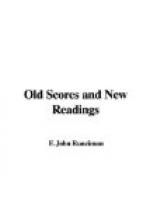her—we know him nearly as well. But
the details in which “Lohengrin” differs
from all other tales of the same order are precisely
those that make it the most enchanting tale of them
all. Lohengrin, knight of the Grail, redeemer,
yet with a touch of tragedy in his fate, drawn down
the river in his magic boat by the Swan from a far
mysterious land, a land of perpetual freshness and
beauty, is an infinitely more poetic notion than the
commonplace angel flapping clumsily down from heaven;
and even if we feel it to be absurd that he should
have to beg his wife to take him on trust, yet, after
all, he takes his wife on trust, and he tells her
at the outset that he cannot reveal the truth about
himself. Elsa is vastly preferable to the ordinary
distressed mediaeval maiden, if only because a woman
who is too weak to be worth a snap of the fingers
does move us to pity, whereas the ordinary mediaeval
is cut out of pasteboard, and does not affect us at
all. The King is perhaps merely a stage figure;
Ortrud is just one degree better than the average
witch of a fairy story; but Frederic, savage and powerful,
but so superstitious as to be at the mercy of his wife,
is human enough to interest us. And Wagner has
managed his story perfectly throughout, excepting
at the end of the second act, where that dreary business
of Ortrud and Frederic stopping the bridal procession
is a mere reminiscence of the wretched stagecraft
of Scribe, and quite superfluous. But if there
is a flaw in the drama, there cannot be said to be
one in the music. The mere fact that, save two
numbers, it is all written in common time counts for
absolutely nothing against its endless variety.
Wagner never again hit upon quite so divine and pure
a theme as that of the Grail, from which the prelude
is evolved; the Swan theme at once carries one in
imagination up the ever-rippling river to that wonderful
land of everlasting dawn and sacred early morning
stillness; and nothing could be more effective, as
background and relief to these, than the warlike music
of the first act, and the ghastly opening of the second
act, so suggestive of horrors and the spells of Ortrud
winding round Frederic’s soul. Then there
is Elsa’s dream, the magical music of Lohengrin’s
tale, the music of the Bridal procession in the second
act, the great and tender melody first sung by Elsa
and Ortrud, and then repeated by the orchestra as Ortrud
allows Elsa to lead her into the house, the whole of
the Bridal-chamber duet, and perhaps, above all, Lohengrin’s
farewell. To whatever page of the score you turn,
there is perfect beauty—after the first
act not a great deal that is powerful or meant to be
powerful, but melody after melody that entrances you
merely as absolute music without poetic significance,
and that seems doubly entrancing by reason of the
strange, remote feeling with which it is charged,
and its perpetual suggestion of the broad stream flowing
ceaselessly from far-away Montsalvat to the sea.
“Lohengrin” is a fairy-story imbued with
seriousness and tender human emotion, and the music
is exactly adapted to it.




